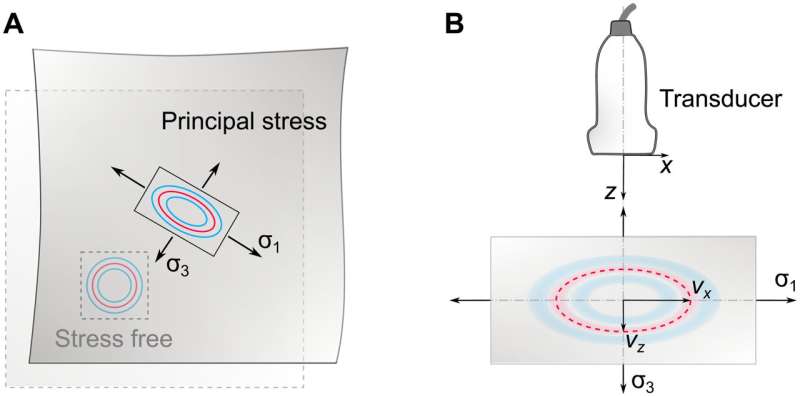
A new ultrasound method that can measure the level of tension in human tissue for the first time—a key indicator of disease—has been developed by researchers from the University of Sheffield.
The breakthrough, made by Dr. Artur Gower from the University’s Department of Mechanical Engineering, together with researchers from Harvard, Tsinghua University, and the University of Galway, could be used to build new ultrasound machines that are able to better diagnose abnormal tissue, scarring, and cancer.
Ultrasounds use sound waves to create images of organs inside the human body. However, the images produced by the current techniques used in healthcare aren’t usually enough to diagnose whether tissues are abnormal. To improve diagnosis, the researchers developed a way to measure forces such as tension by using an ultrasound machine. Tension is generated in all living tissue, so measuring it can indicate whether tissue is functioning properly or if it’s affected by disease.
The researchers harnessed a technique from a rail project at the University of Sheffield, which uses sound waves to measure tension along railway lines. The technique, used both for rail and medical ultrasound, relies on a simple principle: the greater the tension, the faster sound waves propagate. Using this principle, the researchers developed a method that sends two sound waves in different directions. The tension is then related to the speed of the waves by using mathematical theories developed by the researchers.
Previous ultrasound methods have struggled to show the difference between stiff tissue or tissue under tension. The developed technique is the first capable of measuring tension for any type of soft tissue, and without knowing anything about it. In a new paper, published in the journal Science Advances, the researchers describe the new method and demonstrate how they used it to measure tension inside a muscle.
Dr. Artur Gower, lecturer in dynamics at the University of Sheffield, said, “When you go to the hospital, a doctor might use an ultrasound device to create an image of an organ, such as your liver, or another part of your body, such as the gut, to help them explore what the cause of a problem might be. One of the limitations of ultrasounds used in healthcare now is that the image alone is not enough to diagnose whether any of your tissues are abnormal.”
“What we’ve done in our research is develop a new way of using ultrasound to measure the level of tension in tissue. This level of detail can tell us whether tissues are abnormal or if they are affected by scarring or disease. This technique is the first time that ultrasound can be used to measure forces inside tissue, and it could now be used to build new ultrasound machines capable of diagnosing abnormal tissue and disease earlier.”
More information:
Zhaoyi Zhang et al, Noninvasive measurement of local stress inside soft materials with programmed shear waves, Science Advances (2023). DOI: 10.1126/sciadv.add4082
Journal information:
Science Advances
Source: Read Full Article
